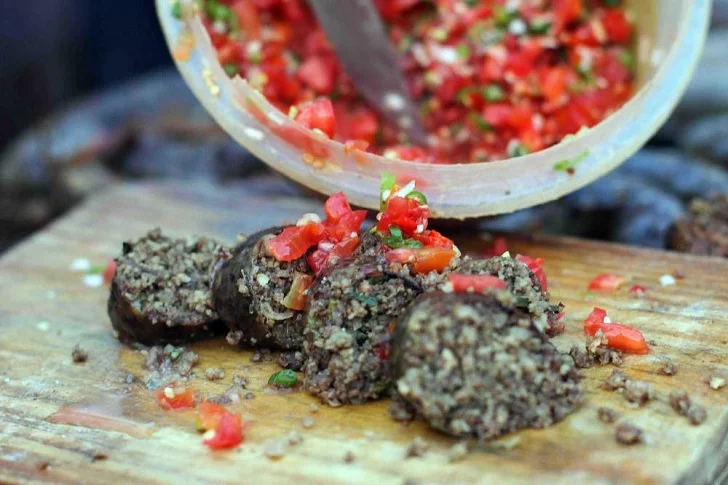Mutura, which is made from goat, cow, or lamb, a mixture of fat and blood, and is packed with spices. This dish is still enjoyed today at celebratory events, but it has a long and contentious history.
History of mutura
Mutura has been plagued by a stigma over the decades. However, before this, the origins of the dish began with the Agikuyu community, also known as the Kikuyu. The dish was prepared only on special occasions, and See Africa Today says that during these events, only men slaughtered the goat and only women consumed the mutura. According to the site, it is common in parts of Africa for men to enjoy the prime cuts of meat around a fire together while cleaning the animal's carcass. Some believe that the sausage was given to the women as a "form of appeasement" for missing out on this.
During Nairobi's colonial period, the city was heavily dominated by the Agikuyu community. Many African communities in the city at this time were being segregated into small housing units as a result of Kenya's apartheid housing laws. Being crammed together in this way caused the tribes' cultures to mingle, including the sharing of food. Soon, mutura ceased being an Agikuyu-only dish and was adopted by other groups. However, this also caused the sausage to carry a stigma of being a low-class food since its popularity spread in housing units that were regarded as "slums."
According to Atlas Obscura, the sausage is still widely enjoyed today during celebratory events, festivities, and gatherings where a cow or a goat is butchered.
Ingredients in mutura
While goat is the traditional animal used to make mutura, beef and lamb are also common options today. Most recipes online call for beef, including Miss Kabaki's recipe. Small cuts of beef, tripe or cow intestine, and cow blood make up the main components of the sausage, and onions, red chili, garlic, salt, and pepper are all used for flavoring. Varsity Scope notes that ginger, garlic, and chiles make this sausage more aromatic and pungent compared to other blood sausages in Europe, for example.
How mutura is made
The traditional and by-hand way of making matura is quite a time-consuming process. However, using today's modern technology can make stuffing a sausage quicker.
The first step in the traditional process of making matura was slaughtering a goat. This included slitting its throat and collecting the blood in a bucket with salt. The goat's neck and back were then cut into small pieces and cooked together with various vegetables, such as eggplants, carrots, and onion. The goat's fat and salted blood was then added to the rest of the meat and fried together with seasonings. This mixture was then stuffed into the animal's intestines, creating mutura. Today, there are many sausage stuffers that you can buy to make the process easier. However, many modern recipes call for making the sausage by hand.
In Jikoni Magic's recipe, she first cooks her vegetables down with beef fat, and then adds her minced beef. She browns the beef, adds seasonings, and simmers it with water until it is fully evaporated. The remaining vegetables are tossed in at this point, and once it cools down, it's ready to stuff. She delicately fills the intestines and makes sure to not overstuff them so they do not burst open when they're boiled, then grilled.
Making mutura can be a tedious process, but if you surround yourself with family or friends to share, it will be a worthy endeavor.
How mutura is eaten
Mutura is still an essential part of Kikuyu ceremonies and family gatherings, just as it was decades ago. The traditional sausage is popular at these gatherings, such as bridewealth ceremonies, as it is an easy way to feed a large number of guests at these events before the main course, according to Slow Food. The dish is often accompanied by alcoholic beverages — and lots of laughter, according to Jikoni Magic. She also notes the making of the dish is a "highly social activity" and is often done with multiple individuals in the kitchen enjoying time together as they stuff the sausages during the event.
The dish can be served by itself as an appetizer, or as the main course alongside a few accompaniments. When it's the centerpiece of a meal, it's typically served with ugali, which is a cornmeal porridge used to scoop up the sausage, per Taste of the Place. Another common accompaniment is kachumbari, which is an East African fresh diced tomato and onion salad that adds brightness to the plate.
The dish is served in both rural and urban areas, however, the dish is currently at risk of disappearing because some of the younger generations gravitate toward more modern sausages. Slow Food says that these newer sausages are "aggressively promoted by marketing companies." However, many Kenyans are fond of this dish and feel it is important to keep the tradition alive.
Why you need to avoid roadside mutura
It comes with several items that pose a danger to your
health. These include:
- H.
pylori
The most joint illness that most people in towns suffer from
is ulcers. The principal causative agent is Helicobacter pylori. This bacteria
is often found in unhygienic environments such as those around the ‘mutura’
base. Avoiding mutura can save you from this nuisance bacteria.
2. Meat
Most people consume mutura without questioning where their
consuming meat came from. Some stories state that this can be from carcasses
meat.
3. Bacteria sink
Apart from the H pylori, mutura can sink various bacterial
strains such as staphylococcus and streptococcus type. These bacteria can pose
a health threat to your body if not checked.

